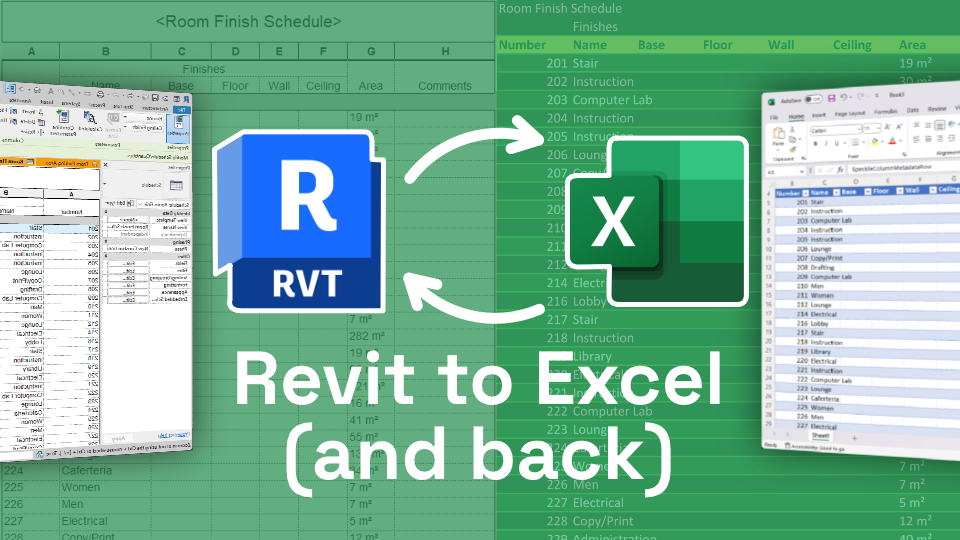Revit Plugins and Tools: Enhancing Your BIM Journey
Wiki Article
Understanding the Art of Data Combination: Just How to Seamlessly Import Excel Files Into Revit
In this post, we will certainly guide you through the process of understanding the art of data assimilation. Get ready to prepare your Excel information effortlessly and follow our detailed overview to import data into Revit. With our best techniques, you'll achieve data assimilation success in no time.Recognizing the Relevance of Data Integration in Revit
Recognizing the significance of data assimilation in Revit is vital for seamless importing of Excel data. When you incorporate data from Excel into Revit, it permits you to efficiently handle and upgrade details throughout the whole job. This assimilation ensures that your layout and building process is updated and exact.By integrating data, you can quickly import and upgrade parameters, routines, and even geometry in Revit. This gets rid of the requirement for manual data access, conserving you time and decreasing the danger of mistakes. With Revit's data integration abilities, you can maintain consistency and accuracy in your task, while also improving cooperation amongst group participants.

Exploring the Excel Documents Layout for Revit Assimilation

In order to successfully incorporate Excel files right into Revit, it is vital to ensure that the data is formatted appropriately. This consists of properly identifying columns and rows, along with structuring the information in a manner that works with Revit's data schema. Revit uses particular parameters and classifications to arrange information, so it is important to align the Excel information with these criteria to ensure a smooth assimilation.
Furthermore, it is important to note that Revit just sustains certain information kinds when importing from Excel. These consist of message, numbers, and days. Any type of various other information types, such as solutions or conditional formatting, will certainly not be recognized by Revit and might create problems during the combination procedure.
Preparing Your Excel Information for Seamless Import Into Revit
To make sure a smooth combination procedure, you'll require to effectively layout and tag the columns and rows in your Excel data prior to importing it right into Revit. Due to the fact that it permits Revit to accurately analyze and organize your information, this action is critical. Start by examining your Excel information and determining which columns and rows consist of pertinent info for your Revit task. After that, make certain to label each column with a clear and descriptive header. This will assist you and others quickly comprehend the purpose of each column and prevent complication throughout the import procedure.Next, guarantee that the data in each column is effectively formatted. As an example, if you have a column for measurements, ensure that all measurements are constantly formatted in the exact same systems of measurement. Revit depends on constant format to properly interpret and import data.
Furthermore, it is important to look for any kind of empty cells or variances in your data. Revit might not be able to check out or import information from cells that are vacant or contain mistakes. For that reason, it is suggested to assess your Excel data and cleanse up any kind of inconsistencies before importing it right into Revit.
Step-By-Step Guide to Importing Excel Info Into Revit
Once you have actually properly formatted and classified your Excel data, you can easily import it right into Revit by following this step-by-step guide. To start, open Revit and browse to the "Insert" tab. Click on "Import CAD" and select "Import Excel" from the dropdown food selection. A new window will certainly appear, asking you to locate the Excel documents you intend to import. Search your computer system and select the Excel documents, after that click "Open."Next, a dialog box will certainly show up, allowing you to tailor the import setups. Here, you can pick the worksheet you wish to import, specify the array of cells to import, and pick the ideal units for your information. As soon as you've made your selections, click "OK" to proceed.
Revit will currently show a sneak peek of your Excel information. Take a minute to assess the sneak peek and ensure that every little thing looks appropriate. If required, you can make changes to the revit plugins import setups by clicking on the "Settings" switch.
Best Practices for Data Integration Success in Revit
Make certain you comply with these best methods to guarantee successful integration of data in Revit. It is vital to arrange your data in Excel prior to importing it right into Revit. Be conscious of the data and devices kinds when mapping the data, as any type of disparities can lead to errors in the combination process.An additional crucial method is to routinely confirm and update your data. Additionally, make use of data validation devices within Revit to recognize any errors or variances in the integrated information.
Lastly, it is suggested to establish a clear operations for information integration. This consists of specifying functions and obligations, establishing up a communication network in between employee, and establishing a routine cadence for information updates and testimonials. By complying with these ideal techniques, you can make sure a seamless and effective combination of data in Revit, inevitably enhancing the performance and precision of your task.
Verdict
In verdict, mastering the art of data integration is essential for smooth import of Excel files right into Revit. Understanding the value of information combination in Revit is the very first step towards effective assimilation. Exploring the Excel file layout for Revit assimilation helps in recognizing the restrictions and demands. Preparing the Excel information appropriately and adhering to a step-by-step guide is essential for a smooth import procedure. By complying with finest methods, you can guarantee data assimilation success in Revit and make one of the most out of your project.When importing data from Excel right into Revit, it is vital to recognize the data style and exactly how it can impact the combination procedure (revit add ins). Revit uses specific specifications and classifications to organize information, so it is vital to align the Excel data with these criteria to guarantee a seamless integration
Be mindful of the information and devices types when mapping the information, as any kind of discrepancies can lead to mistakes in the combination procedure.
In addition, make usage of data recognition devices within Revit to identify any kind of mistakes or variances in the integrated information.

Report this wiki page